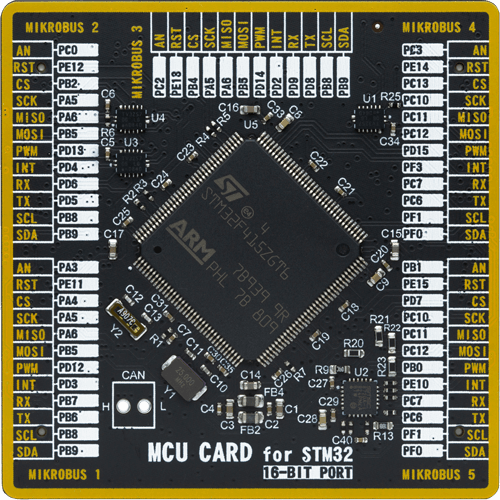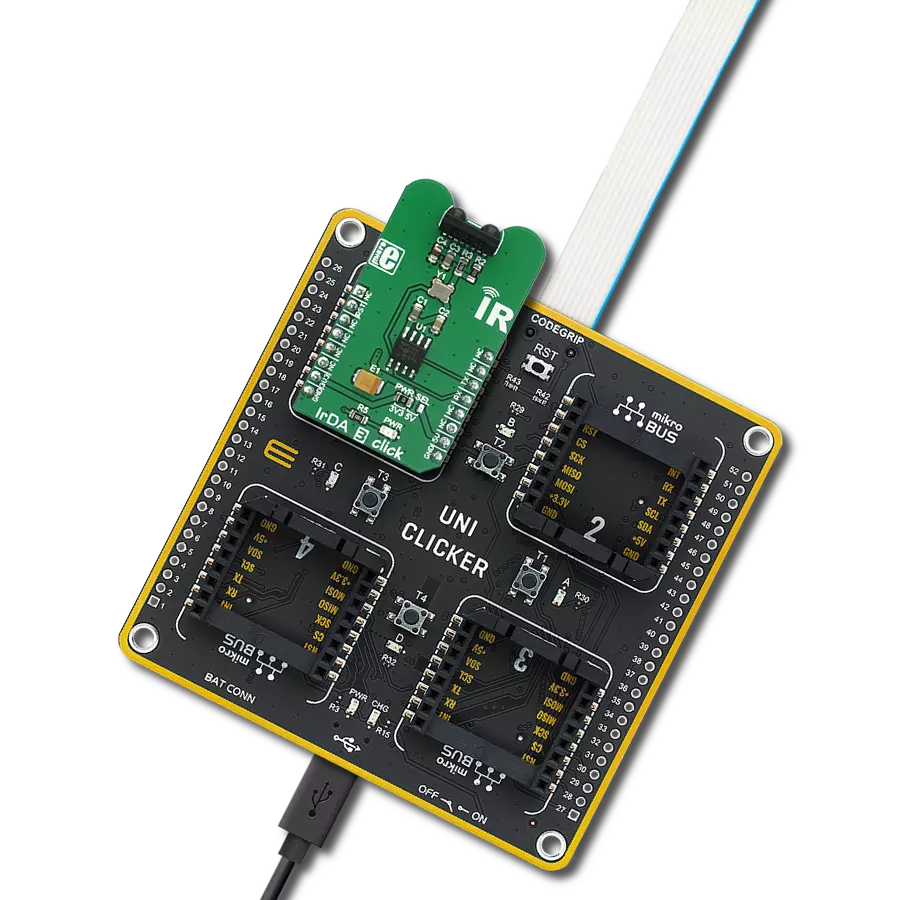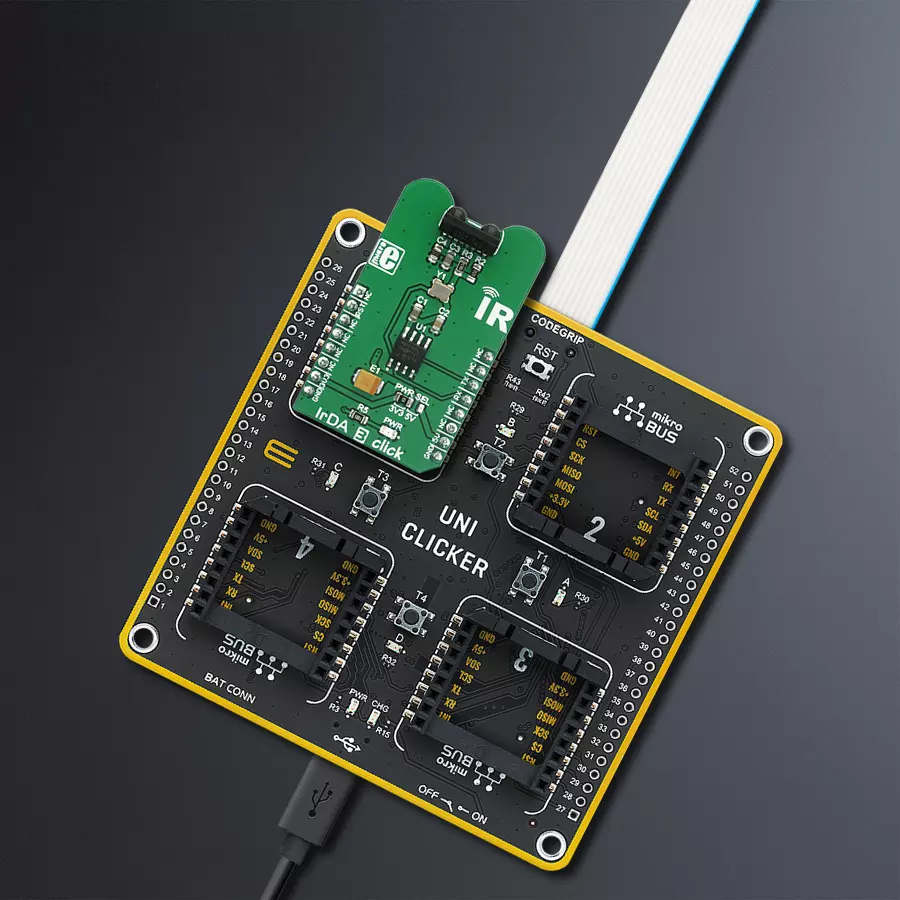Unlock the power of bi-directional IR communication for seamless data exchange and command execution between devices
A
A
Hardware Overview
How does it work?
IrDA 3 Click is based on the TFDU4101, an infrared transceiver module from Vishay compliant to the latest IrDA® physical layer standard. It supports IrDA speeds up to 115.2 Kbps. The transceiver module is composed of the IRED (infrared emitter) and the photodiode IR receiver, which is used to both emit and receive the IR light commands. The range of this device is more than 1m and it depends on several factors. To ensure maximum possible range, the power supply is decoupled with proper capacitors, also the used oscillator is very stable and accurate, resulting with the range of about 4m. The second IC device is the MCP2122, an infrared half duplex encoder/decoder from Microchip that takes care of the proper conversion of the UART signals to TFDU4101 acceptable IrDA
standard compliant data format. The MCP2122 has its UART interface pins routed to the mikroBUS™, and IrDA interface pins routed to the TFDU4101 IrDA module. The maximum communication speed for the UART interface is determined by the onboard oscillator that works at 1.8432MHz. The MCP2122 has the 16XCLK input that acts as a bit clock. The state of the bit is determined within 16 clock cycles of the 16XCLK input. This means that for every bit of the UART information, 16-bit clock cycles are needed - so the UART frequency is the bit clock frequency divided by 16, as shown by this formula: 1,843,200 / 16 = 115,200. At the same time, 115,200 is the maximum baud rate that can be used for the TFDU4101 IrDA transceiver. The click also has a voltage selection jumper for selecting
the voltage between 3.3V and 5V. Besides the UART RX and UART TX signals routed to the mikroBUS™, it also has the RESET signal routed to the RST pin of the mikroBUS™. The RESET pin is used to reset the MCP2122 device. The LOW logic state on this pin will reset the device, while the HIGH state is used for a normal operation. The device can be put in a low power state if the RST pin is held LOW. This Click board™ can operate with either 3.3V or 5V logic voltage levels selected via the PWR SEL jumper. This way, both 3.3V and 5V capable MCUs can use the communication lines properly. Also, this Click board™ comes equipped with a library containing easy-to-use functions and an example code that can be used as a reference for further development.
Features overview
Development board
UNI Clicker is a compact development board designed as a complete solution that brings the flexibility of add-on Click boards™ to your favorite microcontroller, making it a perfect starter kit for implementing your ideas. It supports a wide range of microcontrollers, such as different ARM, PIC32, dsPIC, PIC, and AVR from various vendors like Microchip, ST, NXP, and TI (regardless of their number of pins), four mikroBUS™ sockets for Click board™ connectivity, a USB connector, LED indicators, buttons, a debugger/programmer connector, and two 26-pin headers for interfacing with external electronics. Thanks to innovative manufacturing technology, it allows you to build
gadgets with unique functionalities and features quickly. Each part of the UNI Clicker development kit contains the components necessary for the most efficient operation of the same board. In addition to the possibility of choosing the UNI Clicker programming method, using a third-party programmer or CODEGRIP/mikroProg connected to onboard JTAG/SWD header, the UNI Clicker board also includes a clean and regulated power supply module for the development kit. It provides two ways of board-powering; through the USB Type-C (USB-C) connector, where onboard voltage regulators provide the appropriate voltage levels to each component on the board, or using a Li-Po/Li
Ion battery via an onboard battery connector. All communication methods that mikroBUS™ itself supports are on this board (plus USB HOST/DEVICE), including the well-established mikroBUS™ socket, a standardized socket for the MCU card (SiBRAIN standard), and several user-configurable buttons and LED indicators. UNI Clicker is an integral part of the Mikroe ecosystem, allowing you to create a new application in minutes. Natively supported by Mikroe software tools, it covers many aspects of prototyping thanks to a considerable number of different Click boards™ (over a thousand boards), the number of which is growing every day.
Microcontroller Overview
MCU Card / MCU

Type
8th Generation
Architecture
ARM Cortex-M4
MCU Memory (KB)
1024
Silicon Vendor
STMicroelectronics
Pin count
144
RAM (Bytes)
196608
Used MCU Pins
mikroBUS™ mapper
Take a closer look
Click board™ Schematic

Step by step
Project assembly
Track your results in real time
Application Output
1. Application Output - In Debug mode, the 'Application Output' window enables real-time data monitoring, offering direct insight into execution results. Ensure proper data display by configuring the environment correctly using the provided tutorial.

2. UART Terminal - Use the UART Terminal to monitor data transmission via a USB to UART converter, allowing direct communication between the Click board™ and your development system. Configure the baud rate and other serial settings according to your project's requirements to ensure proper functionality. For step-by-step setup instructions, refer to the provided tutorial.

3. Plot Output - The Plot feature offers a powerful way to visualize real-time sensor data, enabling trend analysis, debugging, and comparison of multiple data points. To set it up correctly, follow the provided tutorial, which includes a step-by-step example of using the Plot feature to display Click board™ readings. To use the Plot feature in your code, use the function: plot(*insert_graph_name*, variable_name);. This is a general format, and it is up to the user to replace 'insert_graph_name' with the actual graph name and 'variable_name' with the parameter to be displayed.

Software Support
Library Description
This library contains API for IrDA 3 Click driver.
Key functions:
irda3_mode_setup- This function allows IrDA 3 click mode to be setirda3_pwr_setup- This function allows IrDA 3 click power mode to be setirda3_reset- This function executes a device reset operation.
Open Source
Code example
The complete application code and a ready-to-use project are available through the NECTO Studio Package Manager for direct installation in the NECTO Studio. The application code can also be found on the MIKROE GitHub account.
/*!
* @file main.c
* @brief IrDA 3 Click Example.
*
* # Description
* This example demonstrates the use of IrDA 3 Click boards.
* The example can perform both roles, transmitter and receiver.
*
* The demo application is composed of two sections :
*
* ## Application Init
* Initializes UART driver and all used control pins.
* Also clears the response buffer.
*
* ## Application Task
* Demonstrates the use of IrDA 3 Clicks which can be used as transmitter or
* receiver. There are four different examples in this project.
* Uncomment one of the below macros to select which example will be executed.
* By default the DEMO_APP_TRANSMITTER_1 example is selected.
*
* @author Jelena Milosavljevic
*
*/
// ------------------------------------------------------------------- INCLUDES
#include "board.h"
#include "log.h"
#include "irda3.h"
// ------------------------------------------------------------------ VARIABLES
#define PROCESS_BUFFER_SIZE 200
//#define DEMO_APP_RECEIVER_1
//#define DEMO_APP_RECEIVER_2
#define DEMO_APP_TRANSMITTER_1
// #define DEMO_APP_TRANSMITTER_2
static irda3_t irda3;
static log_t logger;
static char tx_message[ ] = { 'M', 'i', 'k', 'r', 'o', 'E', '\r', '\n', '\0' };
static char rx_message[ 10 ];
static uint8_t idx;
// ------------------------------------------------------ APPLICATION FUNCTIONS
void application_init( void ) {
irda3_cfg_t irda3_cfg;
log_cfg_t logger_cfg;
/**
* Logger initialization.
* Default baud rate: 115200
* Default log level: LOG_LEVEL_DEBUG
* @note If USB_UART_RX and USB_UART_TX
* are defined as HAL_PIN_NC, you will
* need to define them manually for log to work.
* See @b LOG_MAP_USB_UART macro definition for detailed explanation.
*/
LOG_MAP_USB_UART( logger_cfg );
log_init( &logger, &logger_cfg );
log_printf( &logger, "*** IrDA initialization done ***\r\n" );
log_printf( &logger, "**********************************\r\n" );
// Click initialization.
irda3_cfg_setup( &irda3_cfg );
IRDA3_MAP_MIKROBUS( irda3_cfg, MIKROBUS_1 );
irda3_init( &irda3, &irda3_cfg );
irda3_default_cfg( &irda3 );
irda3_reset( &irda3 );
// Clear response.
memset( rx_message, 0, sizeof( rx_message ) );
}
void application_task( void ) {
#ifdef DEMO_APP_RECEIVER_1
rx_message[ 0 ] = irda3_generic_single_receive( &irda3 );
if ( rx_message[ 0 ] != 0 ) {
log_printf( &logger, "%c", ( char ) rx_message[ 0 ] );
}
Delay_ms ( 100 );
#endif
#ifdef DEMO_APP_RECEIVER_2
irda3_generic_multiple_receive( &irda3, rx_message, '\n' );
log_printf( &logger, "RECEIVED MESSAGE : " );
log_printf( &logger, "%s\r\n", rx_message );
Delay_ms ( 100 );
#endif
#ifdef DEMO_APP_TRANSMITTER_1
irda3_generic_multiple_send( &irda3, tx_message );
log_printf( &logger, "MESSAGE SENT\r\n" );
Delay_ms ( 1000 );
Delay_ms ( 1000 );
#endif
#ifdef DEMO_APP_TRANSMITTER_2
idx = 0;
while ( tx_message[ idx ] != '\0' ) {
irda3_generic_single_send( &irda3, tx_message[ idx++ ] );
}
log_printf( &logger, "MESSAGE SENT\r\n" );
Delay_ms ( 1000 );
Delay_ms ( 1000 );
#endif
}
int main ( void )
{
/* Do not remove this line or clock might not be set correctly. */
#ifdef PREINIT_SUPPORTED
preinit();
#endif
application_init( );
for ( ; ; )
{
application_task( );
}
return 0;
}
// ------------------------------------------------------------------------ END

































